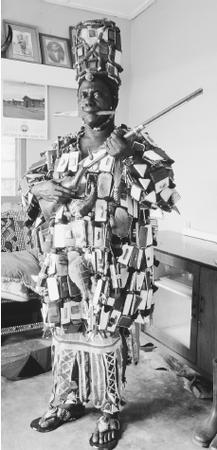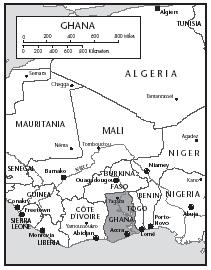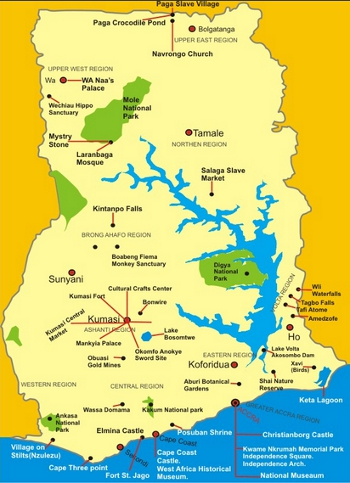Situated on the southern coast of the West African bulge, Ghana has an area of 238,540 square kilometers (92,100 square miles), extending 672 kilometers (418 miles) from north to south and 536 kilometers (333 miles) from east to west. Comparatively, the area occupied by Ghana is slightly smaller than the state of Oregon. Ghana's capital city, Accra, is located on the Gulf of Guinea coast.
The climate is tropical but relatively mild with two rainy seasons (April through June and from September to November). A serious environmental problem in Ghana is desertification (land that once supported plant life changing into barren desert). This is caused by poor land management practices, such as overgrazing, heavy logging, and slash-and-burn agriculture (where the land is cleared by cutting down all plants and trees and then burning away the remaining brush and stumps).
2 HISTORY AND FOOD
Ghana's earliest inhabitants existed as long ago as 6000 B.C. Ancient stone tools and other artifacts have been discovered that suggest early hunter-gatherer communities, most of which lived by the ocean. These nomadic tribes (traveling from one place to another) roamed the land in search of berries and wild seeds, and followed herds of animals for meat.
Ancient trade routes existed long before the arrival of the first Europeans in 1471. Trade routes running north to south, and east to west, many of which ran through Ghana, existed throughout the continent of Africa. Modern-day Ghana imported dates, salt (for food preservation), tobacco, and copper from northern territories, while
Ghana offered ostrich feathers, cloth, and cola nuts in return.
The Portuguese arrived in modern-day Ghana in 1471, the first Europeans to explore the land. Though they were searching for a sea route to the Far East, the explorers began building forts along the coast and trading with inland tribes for their gold. By 1600, the Dutch and English began exploring Ghana. One hundred years later, the Germans and Danes also built forts—all hoping for ivory and gold. In return, explorers brought rum, cotton, cloth, beads, and weapons to the tribesmen. Eventually the Europeans forcefully captured Ghanaians as slaves.
In addition to ivory and gold, Ghana was exporting palm oil, pepper, and corn by the mid-1800s. By 1902, the British had driven out all other European powers and named their new British colony the Gold Coast (it was later named Ghana in 1957). To continue the economic development of Ghana, the government distributed cocoa beans to local farmers to encourage the growth of a cocoa industry. At the beginning of the twenty-first century, Ghana's economy continued to be largely reliant on the exports of gold and cocoa. Bananas, cola nuts (the basic ingredient of many cola drinks), coconuts, rice, palm fruit, and various citrus fruits have also flourished into profitable cash crops.
Yams
African yams taste slightly different than Western yams, but Western yams may be used.Ingredients
- 4 yams (a sweet potato may be substituted)
- Salt, pepper, and butter, to taste
Procedure
- Preheat oven to 375°F.
- Scrub yams. Wrap each in aluminum foil (or banana leaves, available at some specialty food stores), as one would wrap baking potatoes.
- Bake for 45 minutes, or until tender when pricked with a fork.
- Be very careful unwrapping foil from yams.
- Serve with salt, pepper, and butter.
Serves 4 (or more).
3 FOODS OF THE GHANAIANS
Ghanaians enjoy a rather simple, but flavorful cuisine. The majority of meals consist of thick, well-seasoned stews, usually accompanied by such staple foods as rice or boiled yams. Stews come in a variety of flavors, the most popular being okra, fish, bean leaf (or other greens),
forowe (a fishy tomato stew),
plava sauce (spinach stew with either fish or chicken), and groundnut (peanut), one of the country's national dishes.
Many spices are used to prepare stews and other popular dishes. Cayenne, allspice, curry, ginger, garlic, onions, and chili peppers are the most widely used seasonings. Onions and chili peppers (along with tomatoes, palm nuts, and broth) help to make up the basis for most stews.
Certain foods that make up the Ghanaian diet vary according to which region of the country people live in. In the north, millet (a type of grain), yams, and corn are eaten most frequently, while the south and west enjoy plantains (similar to bananas), cassava, and cocoyams (a root vegetable).
The people of the dry southeastern region eat mostly corn and cassava. Rice is a staple throughout most of the country.
Jol lof rice , a spicy dish that includes tomato sauce and meat, is enjoyed by most of the population.
Pito , a fermented beverage made from sorghum (a type of grain), is a popular drink in the north, while those living in the south prefer palm wine.
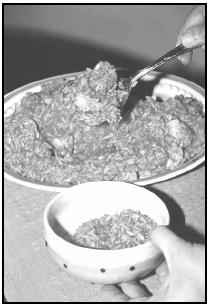
Jollof rice, tomato-flavored rice to which meat or fish is often added, may be served hot or at room temperature.EPD Photos
Jollof Rice
Ingredients
- 1¼ cups white rice
- 1 medium onion, chopped
- 1 pound boneless, skinless chicken breast
- 2 teaspoons vegetable oil
- 1 can (6-ounce) tomato paste
- 3 cups chicken broth
Procedure
- In a saucepan sauté rice and onion in oil.
- Cover and cook until onion is translucent and soft.
- Cut chicken into ½-inch cubes and add to sauté mixture.
- Mix in tomato paste and then broth.
- Bring mixture to a boil.
- Cover pan and reduce heat to low.
- Cook until rice is tender, liquid is absorbed, and chicken is cooked, about 20 to 25 minutes.
Makes 8 servings.
A staple throughout West Africa, including Ghana, is
fufu (boiled plantain, cassava, or rice that is pounded with a large mortar and pestle into a round ball). Other commonly eaten vegetables include spinach, okra, eggplant, onions, tomatoes, sweet potatoes, beans, corn, and cocoyams. Some villagers eat
bangu , a fermented corn dish, or corn on the cob with pieces of coconut.
Meat is considered a sign of wealth and luxury in Ghana and is seldom eaten. Fish, especially near the coast, is found more often in everyday dishes and stews.
Kyemgbuma , crabs with cassava dough, meat, and potatoes, and
gari foto (eggs, onions, dried shrimp, and tomatoes) accompanied by
gari (coarse manioc flour) are popular seafood dishes.
There are many treats for Ghanaians to enjoy after meals. Surprisingly, not many of them include chocolate as an ingredient, despite Ghana being one of the world's leading producers of cocoa.
Kelewele , a dessert or snack, is made of fried plantains seasoned with ginger and ground red pepper or fresh chili peppers. Another dish that may be served for dessert is a pancake made of mashed plantains, deep-fried in palm oil.
Fufu
Ingredients
- 6 cups water
- 2½ cups instant baking mix (such as Bisquick or Jiffy Mix)
- 2½ cups instant mashed potato flakes
Procedure
- Boil the water in a large saucepan.
- Add the instant flour mix and potato flakes to the boiling water and mix well.
- Cook, stirring constantly for 10 to 15 minutes.
- This is best accomplished by two people working together: one to hold the pot while the other stirs vigorously with a strong, wooden spoon.
- The mixture will become very thick and difficult to stir, but the mixture must continuously be stirred.
- Fill a medium-sized bowl with water to thoroughly wet its surface, then empty the water out.
- Gather a large mass of the mixture (about 1 cup) on the spoon and transfer it to the wet bowl.
- Shake the bowl vigorously until the dough forms into a smooth ball.
- Serve on a large platter with soup or stew.
Makes about 6 servings.
Kelewele (Fried Plantains)
Ingredients
- 6 large ripe plantains
- 1 teaspoon powdered ginger
- ½ teaspoon salt
- ½ teaspoon ground red pepper
- 2 Tablespoons water
- 3 cups oil or shortening
Procedure
- Peel the plantain and cut crosswise into ½-inch slices, removing any woody parts from the center.
- Mix ginger, salt, and red pepper with water in a mixing bowl.
- Drop plantain slices into mixture and turn them to coat.
- Heat oil or shortening in a large skillet and fry the mixture-coated slices until golden brown.
Serves 6.
Groundnut Toffee (Peanut Toffee)
Ingredients
- 1¼ cups sugar
- 1 Tablespoon butter
- 2 cups roasted peanuts
Procedure
- Measure sugar into a saucepan and heat over medium high heat.
- Heat for about 5 minutes, stirring frequently.
- The sugar will melt and brown lightly.
- Add butter and mix well.
- Slowly stir in nuts until well-coated.
- Dampen a pastry board and pour the toffee mixture onto it. (Be careful because mixture will be hot.)
- Roll toffee into balls, using a metal or wooden spoon.
- Cool and store in a tight, plastic container.
Makes about 2 dozen toffee balls.
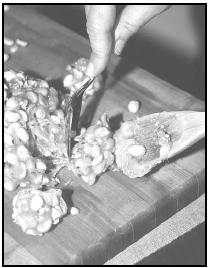
Two spoons are used to separate the sticky Groundnut Toffee mixture into balls. Groundnuts (peanuts) are used in many recipes, from main courses to desserts.EPD Photos
4 FOOD FOR RELIGIOUS AND HOLIDAY CELEBRATIONS
The government does not recognize any religion as Ghana's official national religion. This is because Ghanaians believe in several different religions. Roughly 60 percent are Christians, 15 percent are Muslims (believers in the Islamic religion), and the remainder of the population practices a form of indigenous religion that existed hundreds of years before the introduction of Christianity or Islam. Such beliefs are called animism, the belief that all objects possess a spirit that is capable of causing both harm and good to those who come in contact with it.
The Portuguese introduced Christianity to Ghana in the 1400s, though Christian missionaries in the 1800s were most responsible for spreading the faith. In modern-day Ghana, the majority of Christians live near the coastal regions and enjoy taking part in Christian holidays.
Christmas is a special time of year for all Christians, including the Ghanaians, who observe Christmas for up to eight days. It is a time when relatives and friends visit one another and children receive new clothes and toys. The most popular dish at Christmas dinner is chicken, though goat or sheep may also be prepared for the special occasion. Yams and stew or soup are popular accompaniments served with the main dish. Fresh fruits and sweet treats are often offered for dessert. Muslims celebrate Islamic holidays (such as Ramadan) with as much anticipated joy, though they rarely consume pork or alcohol.
More than 100 festivals take place throughout Ghana each year, many of which are based on animistic beliefs and revolve around times of harvest. They typically pay tribute to their ancestors. These vibrant festivals give the Ghanaians a feeling of spiritual and cultural connection. All festivals, even somber ones, involve dancing, singing, and feasting.
One of the most popular festivals is
Odwira , the presentation of the new harvest of yams to their ancestors. The weeklong festival in either September or October (depending on the harvest) follows strict guidelines each year. One rule prohibits the consumption of new yams until the festival has ended. On the fourth day before the start of the festival, a huge feast is held in honor of the living and the dead and feasts are held at the center of many towns.
A Typical Ghanaian Christmas Menu
Chicken, goat, or sheep
Chicken stew
Cooked rice or jollof rice
Boiled soybeans, yams, or eggplant
Fufu
Gari biscuits
Mangoes, oranges, or pawpaws (papayas)Independence Day is joyously observed each year on March 6 in remembrance of Ghana's independence from Great Britain in 1957. Fireworks, sporting events, awards shows, and cultural displays are all a part of the festivities. As in most of West Africa, the yam or plantain (similar to the banana) dish called
fufu is a favorite dish to eat on this special day. A yam dish called
oto is served with hard-boiled eggs for breakfast on festival mornings.
Gari Biscuits
Ingredients
- 5 cassavas
- 3 eggs
- ½ cup milk
- ¾ cup sugar
- 1 teaspoon nutmeg
- 1 Tablespoon flour
Procedure
- Preheat oven to 350°F.
- Peel, clean, and grate the cassavas.
- Using a whisk or wooden spoon, beat the eggs and milk together in a mixing bowl.
- Add the grated cassavas, sugar, nutmeg, and flour; mix well.
- Roll out with a rolling pin and cut into circular shapes.
- On a greased cookie sheet, bake for 15 minutes, or until a light, golden color.
- Watch them carefully so they do not burn.
Makes about 2 dozen biscuits.
Oto (Yams & Eggs)
Ingredients
- 2 cups mashed yams, or mashed white potatoes
- 2 Tablespoons onions, grated
- ¾ cup palm oil (vegetable oil may be substituted)
- 1 ripe tomato, peeled and diced (optional)
- 6 hard-boiled eggs
- Salt and pepper, to taste
Procedure
- Boil the yams or potatoes, then mash smoothly with a fork (or prepare the instant mashed potatoes using directions on package, but using water instead of milk).
- Prepare the sauce in a separate saucepan by frying the onions with salt and pepper in palm oil.
- Add the tomatoes, if desired, and remove the saucepan from heat.
- Mash the solid egg yolks from 2 of the hard-boiled eggs, and stir into the sauce mixture.
- Stir sauce into mashed yams and mix well until the color is even.
- Empty the oto into a bowl and decorate with remaining whole hard-boiled eggs.
Makes 4 to 6 servings.
5 MEALTIME CUSTOMS
Ghanaians traditionally consume three meals a day and each meal is usually only one course. The typical kitchen contains an open fire, a clay oven, a large pot for cooking large quantities of food (such as stew), and a large iron griddle for frying. Although each ethnic group has its own style of cooking, most Ghanaians typically cook by their own instincts, adding ingredients as necessary and determining preparation and cooking times simply by monitoring their meals.
Breakfast is occasionally more substantial than the light, midday snack that some groups consume. Ampesi (am-PEH-si ) is a popular dish eaten in the morning. It consists of a cassava, cocoyam, yam, and plantain mixture that is boiled with onion and fish, and then pounded and boiled a second time. Kenkey (ken-KAY) may be eaten morning, midday, or in the evening. Ground cornmeal is soaked in water and left to ferment for up to two full days before it is shaped into a ball, boiled, and wrapped in plantain leaves. It is a popular accompaniment to fish or stew. Pumpuka , a porridge made from ground millet, is another breakfast dish.
Dishes served for lunch and dinner are typically very similar. Fufu (cassava, plantain, or cocoyam dough), palm fruit, fish, beans, eggplant, and groundnuts are often eaten alone or combined and eaten over rice, or as ingredients in a stew. Pepper soup is hot and spicy, but loved by most Ghanaians. To offset the spicy pepper, drinks native to Ghana such as Refresh, a soft drink made with fresh fruit juice, are extremely popular, especially among children who enjoy its sweet taste. Fried bean cakes called kose (or akara ), boiled plantains, and koko , porridge made from corn or millet mixed with milk and sugar, are all popular meals for school children.
Sundays are often the day for wealthier Ghanaians to eat out, especially those living in the coastal regions. Cheaper café-like establishments called "chop houses" sell local food and are popular among locals and tourists alike. However, street stalls sell local dishes for the least amount of money. Most chop houses and street stalls are run by women. Stalls often sell fresh fruit, kelewele (fried plantains), and porridge.Groundnut Stew
Ingredients
- 3 Tablespoons vegetable oil
- 2 medium onions, chopped
- 2 carrots, chopped
- 1 green pepper, chopped
- 1 can tomatoes (28 ounces)
- 1 can black beans (14 ounces)
- 1 teaspoon salt
- 1–2 teaspoons red pepper (to taste)
- ¾ cup chunky peanut butter
Procedure
- Measure oil into a large saucepan and heat over medium-high heat.
- Add onions and carrots and sauté, stirring with a wooden spoon, until vegetables are softened.
- Add green pepper and continue cooking a about 5 more minutes.
- Stir in canned tomatoes with liquid (do not drain them), canned black beans, salt, and red pepper. Lower heat, cover, and simmer about 15 minutes.
- Stir in peanut butter and continue simmering, covered for 10 more minutes. Serve hot.
Serves 6.
Kenkey (Ground Cornmeal)
Ingredients
- 6 to 8 cups cornmeal
- Banana leaves or cornhusks, available at African, Asian, or Latino groceries (or aluminum foil may be substituted)
- 1 Tablespoon vinegar
- 1 cup water (for boiling)
Procedure
- In a large container, combine the cornmeal with just enough warm water to dampen all of it; mix well.
- Cover the container with a clean cloth and set it in a warm place for 6 hours (normal fermentation takes 2 to 3 days).
- After the time has passed, add vinegar to cornmeal and mix well.
- Knead the dough with your hands until it is thoroughly mixed and slightly stiffened. Divide the dough into 2 equal parts.
- In a large pot, bring water to a boil. Slowly add half of the dough and cook for about 10 minutes, stirring constantly and vigorously. Remove from heat.
- This half of the dough is called the aflata .
- Combine the aflata with the remaining uncooked dough half; mix well.
- Divide the entire dough mixture into serving-sized pieces and tightly wrap the pieces in the leaves, husks, or foil.
- Place the wrapped dough on a wire rack above water in a large pot.
- Bring to a boil and steam for 1 to 3 hours, depending on their size and thickness.
- Serve at room temperature.
Pepper Soup
Ingredients
- 2 Tablespoons cooking oil
- 2 medium onions, quartered
- 1 pound stew beef (chicken may be substituted)
- 2 chili peppers, chopped
- 2 tomatoes, chopped
- 1 small can tomato paste
- 1 teaspoon thyme
- 1 teaspoon curry powder
- Salt and pepper, to taste
Procedure
- Heat oil in a large pot.
- Fry onions in a small amount of oil in a skillet for a few minutes.
- Add beef or chicken to pot and cover with water.
- Bring to a boil and allow to cook until meat begins to become tender.
- Reduce heat and add remaining ingredients and seasonings. Stir well.
- Simmer for ½ hour.
Makes 4 servings.
Akara (Fritters)
Ingredients
- 2 to 3 cups dried black-eyed peas
- 1 onion, finely chopped
- ½ teaspoon salt
- 1 chili pepper or sweet green or red pepper, finely chopped, or to taste
- Cayenne pepper, to taste
- Vegetable oil, for frying
Procedure
- Rinse peas under running water and soak them in a bowl of water for a few hours or overnight.
- After they are soaked, rub them together between your hands to remove their skins.
- Rinse again to wash skins away. Drain them in a sieve.
- Crush, grind, or mash the peas into a thick paste.
- Add enough water to form a smooth, thick batter that will cling to a spoon.
- Add remaining ingredients (not including oil) and mix well.
- Heat the oil in a skillet over medium heat.
- Make fritters by scooping up a spoonful of batter and using another spoon to quickly push the batter into the hot oil.
- Fry the fritters until they are golden brown. Turn them frequently to brown evenly.
Makes about 2 dozen fritters.
6 POLITICS, ECONOMICS, AND NUTRITION
About 11 percent of the population of Ghana is classified as undernourished by the World Bank. This means they do not receive adequate nutrition in their diet. Of children under the age of five, about 27 percent are underweight, and more than one-quarter are stunted (short for their age). Goiter (a swelling of the thyroid gland) was present in one-third of all school children between 1990 and 1995. This is usually a sign of an iodine deficiency. However, Ghanaians consume a fairly large amount of yams, which contain Vitamin B 1 (thiamin) and Vitamin C. Vitamin B 1 helps the body use energy foods and Vitamin C helps to keep the body tissues strong and helps the body to use iron. Yams also provide some fiber, which helps keep the digestive system working properly.
Northern Ghana suffers harsher, more extreme weather conditions than the south, causing less food to be available during times of disaster. Floods during the wet season and droughts during the dry season can lead to serious health risks, including under-nourishment. Southern Ghana experiences more stable conditions and is located closer to seaports. Food in the south can also be more efficiently stored, and most people can afford to buy food from markets when weather conditions destroy their crops.7 FURTHER STUDY
Books
Levy, Patricia.
Ghana: Cultures of the World . Tarrytown, N.Y.: Marshall Cavendish Corporation, 1999.
Webster, Cassandra Hughes.
Mother Africa's Table: A Chronicle of Celebration through West African & African American Recipes and Cultural Traditions . New York: Doubleday, 1998.
Web Sites
African Food Recipes: The Congo Cookbook. [Online] Available
http://www.geocities.com/NapaValley/Vineyard/9119/ (accessed April 18, 2001).
Christmas in Ghana. [Online] Available
http://www.christmas.com/pe/1243 (accessed April 17, 2001).
Detroit Free Press ("FreeP"). [Online] Available
http://www.freep.com/fun/food/hotrec9_20000209.htm (accessed April 18, 2001).
Ghanaian Food. [Online] Available
http://users.erols.com/johnston/food.htm (accessed April 17, 2001).
Read more: Food in Ghana - Ghanaian Food, Ghanaian Cuisine - popular, dishes, diet, history, meals, staple, rice, main, people, favorite, make, customs, fruits, country, vegetables, drink, typical, stew, different, fried http://www.foodbycountry.com/Germany-to-Japan/Ghana.html#ixzz1PcUYjrwj
